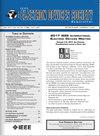A 1.1-nJ/Classification True Analog Current Computing on Multilayer Neural Network With Crystalline-IGZO/Si-CMOS Monolithic Stack Technology
IF 2
3区 工程技术
Q3 ENGINEERING, ELECTRICAL & ELECTRONIC
引用次数: 0
Abstract
We prototyped a true analog current computing multilayer neural network (NN) chip, where multiple analog in-memory computing (AiMC) circuit blocks are connected to each other via simple analog non-linear operation circuits. The true analog current computing is achieved with the invention of an analog current rectified linear unit (ReLU) circuit of a three-stage current mirror. With the prototyped NN chip, we demonstrated that the true analog computing (1) achieves process variation compensation utilizing current driving, (2) eliminates digital-analog or analog-digital data conversion between NNs, and (3) realizes low power inference, not only in multiply-accumulate (MAC) but in ReLU operation. Through classification of Mixed National Institute of Standards and Technology dataset, the chip exhibits a low energy of 1.1 nJ/classification and an accuracy of 91.6%, achieves weight retention of five hours, much longer than dynamic random access memory, and enables 68% power reduction compared with serially connected two single-layer NN chips with analog-digital converters and digital-analog converters in between. Although periodic refresh from an external storage class memory is necessary for applications that require continuous operation exceeding five hours, our AiMC capable of MAC and non-linear operations with low power is effective in applications such as edge artificial intelligence terminals with limited power sources.利用晶体-IGZO/Si-CMOS 单片叠层技术的多层神经网络计算 1.1-nJ/Classification 真实模拟电流
我们制作了真正的模拟电流计算多层神经网络(NN)芯片原型,其中多个模拟内存计算(AiMC)电路块通过简单的模拟非线性运算电路相互连接。三级电流镜的模拟电流整流线性单元(ReLU)电路的发明实现了真正的模拟电流计算。通过原型 NN 芯片,我们证明了真正的模拟计算:(1) 利用电流驱动实现了工艺变化补偿;(2) 消除了 NN 之间的数模或模数数据转换;(3) 实现了低功耗推理,不仅在乘法累加(MAC)中如此,在 ReLU 运算中也是如此。通过对美国国家标准与技术研究院的混合数据集进行分类,该芯片实现了 1.1 nJ/分类的低能耗和 91.6% 的准确率,重量保持时间长达 5 小时,远远超过动态随机存取存储器,与串行连接的两个单层 NN 芯片(中间带有模拟数字转换器和数字模拟转换器)相比,功耗降低了 68%。虽然对于需要连续工作超过五小时的应用来说,从外部存储类存储器定期刷新是必要的,但我们的 AiMC 能够以低功耗进行 MAC 和非线性操作,在诸如电源有限的边缘人工智能终端等应用中非常有效。
本文章由计算机程序翻译,如有差异,请以英文原文为准。
求助全文
约1分钟内获得全文
求助全文
来源期刊

IEEE Journal of the Electron Devices Society
Biochemistry, Genetics and Molecular Biology-Biotechnology
CiteScore
5.20
自引率
4.30%
发文量
124
审稿时长
9 weeks
期刊介绍:
The IEEE Journal of the Electron Devices Society (J-EDS) is an open-access, fully electronic scientific journal publishing papers ranging from fundamental to applied research that are scientifically rigorous and relevant to electron devices. The J-EDS publishes original and significant contributions relating to the theory, modelling, design, performance, and reliability of electron and ion integrated circuit devices and interconnects, involving insulators, metals, organic materials, micro-plasmas, semiconductors, quantum-effect structures, vacuum devices, and emerging materials with applications in bioelectronics, biomedical electronics, computation, communications, displays, microelectromechanics, imaging, micro-actuators, nanodevices, optoelectronics, photovoltaics, power IC''s, and micro-sensors. Tutorial and review papers on these subjects are, also, published. And, occasionally special issues with a collection of papers on particular areas in more depth and breadth are, also, published. J-EDS publishes all papers that are judged to be technically valid and original.
 求助内容:
求助内容: 应助结果提醒方式:
应助结果提醒方式:


